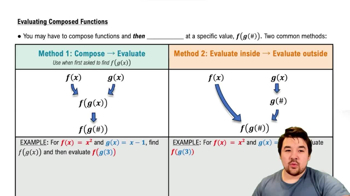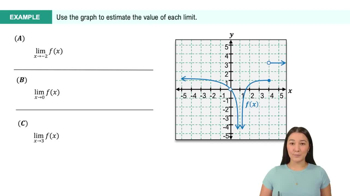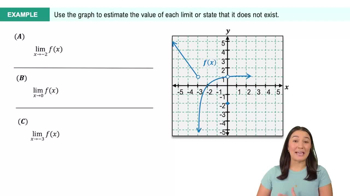Table of contents
- 0. Functions7h 52m
- Introduction to Functions16m
- Piecewise Functions10m
- Properties of Functions9m
- Common Functions1h 8m
- Transformations5m
- Combining Functions27m
- Exponent rules32m
- Exponential Functions28m
- Logarithmic Functions24m
- Properties of Logarithms34m
- Exponential & Logarithmic Equations35m
- Introduction to Trigonometric Functions38m
- Graphs of Trigonometric Functions44m
- Trigonometric Identities47m
- Inverse Trigonometric Functions48m
- 1. Limits and Continuity2h 2m
- 2. Intro to Derivatives1h 33m
- 3. Techniques of Differentiation3h 18m
- 4. Applications of Derivatives2h 38m
- 5. Graphical Applications of Derivatives6h 2m
- 6. Derivatives of Inverse, Exponential, & Logarithmic Functions2h 37m
- 7. Antiderivatives & Indefinite Integrals1h 26m
- 8. Definite Integrals4h 44m
- 9. Graphical Applications of Integrals2h 27m
- 10. Physics Applications of Integrals 2h 22m
1. Limits and Continuity
Introduction to Limits
Problem 2.7.19
Textbook Question
Use the precise definition of a limit to prove the following limits. Specify a relationship between ε and δ that guarantees the limit exists.
lim x→1 (8x+5)=13
 Verified step by step guidance
Verified step by step guidance1
Step 1: Recall the precise definition of a limit. The limit of a function f(x) as x approaches a value c is L if for every ε > 0, there exists a δ > 0 such that if 0 < |x - c| < δ, then |f(x) - L| < ε.
Step 2: Identify the function f(x) and the values of c and L from the given limit. Here, f(x) = 8x + 5, c = 1, and L = 13.
Step 3: Set up the inequality |f(x) - L| < ε using the function and limit value. This becomes |(8x + 5) - 13| < ε, which simplifies to |8x - 8| < ε.
Step 4: Simplify the inequality |8x - 8| < ε to find a relationship between x and ε. This simplifies to 8|x - 1| < ε, which further simplifies to |x - 1| < ε/8.
Step 5: Establish the relationship between ε and δ. From the inequality |x - 1| < ε/8, we can choose δ = ε/8. Therefore, for every ε > 0, if 0 < |x - 1| < δ, then |f(x) - 13| < ε, proving the limit.
 Verified video answer for a similar problem:
Verified video answer for a similar problem:This video solution was recommended by our tutors as helpful for the problem above
Video duration:
2mPlay a video:
Was this helpful?
Key Concepts
Here are the essential concepts you must grasp in order to answer the question correctly.
Limit Definition
The precise definition of a limit states that for a function f(x) to approach a limit L as x approaches a value a, for every ε > 0, there exists a δ > 0 such that if 0 < |x - a| < δ, then |f(x) - L| < ε. This formalizes the intuitive idea of limits and is essential for proving limit statements rigorously.
Recommended video:

Definition of the Definite Integral
Epsilon-Delta Relationship
In the context of limits, the ε (epsilon) represents how close f(x) must be to the limit L, while δ (delta) represents how close x must be to the point a. Establishing a relationship between ε and δ is crucial for proving that the limit exists, as it ensures that for any desired closeness to the limit, we can find a corresponding closeness to the point of interest.
Recommended video:

Finding Differentials
Function Evaluation
To prove the limit lim x→1 (8x + 5) = 13, we first evaluate the function at x = 1, yielding f(1) = 8(1) + 5 = 13. This evaluation is a critical step in the limit proof, as it confirms that the function approaches the expected limit value as x approaches 1, thereby supporting the overall limit statement.
Recommended video:

Evaluating Composed Functions

 6:47m
6:47mWatch next
Master Finding Limits Numerically and Graphically with a bite sized video explanation from Callie
Start learning





